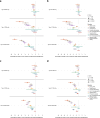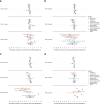The impact of hypoglycaemia on daily functioning among adults with diabetes: a prospective observational study using the Hypo-METRICS app
- PMID: 39080044
- PMCID: PMC11447150
- DOI: 10.1007/s00125-024-06233-1
The impact of hypoglycaemia on daily functioning among adults with diabetes: a prospective observational study using the Hypo-METRICS app
Abstract
Aims/hypothesis: The aim of this work was to examine the impact of hypoglycaemia on daily functioning among adults with type 1 diabetes or insulin-treated type 2 diabetes, using the novel Hypo-METRICS app.
Methods: For 70 consecutive days, 594 adults (type 1 diabetes, n=274; type 2 diabetes, n=320) completed brief morning and evening Hypo-METRICS 'check-ins' about their experienced hypoglycaemia and daily functioning. Participants wore a blinded glucose sensor (i.e. data unavailable to the participants) for the study duration. Days and nights with or without person-reported hypoglycaemia (PRH) and/or sensor-detected hypoglycaemia (SDH) were compared using multilevel regression models.
Results: Participants submitted a mean ± SD of 86.3±12.5% morning and 90.8±10.7% evening check-ins. For both types of diabetes, SDH alone had no significant associations with the changes in daily functioning scores. However, daytime and night-time PRH (with or without SDH) were significantly associated with worsening of energy levels, mood, cognitive functioning, negative affect and fear of hypoglycaemia later that day or while asleep. In addition, night-time PRH (with or without SDH) was significantly associated with worsening of sleep quality (type 1 and type 2 diabetes) and memory (type 2 diabetes). Further, daytime PRH (with or without SDH), was associated with worsening of fear of hyperglycaemia while asleep (type 1 diabetes), memory (type 1 and type 2 diabetes) and social functioning (type 2 diabetes).
Conclusions/interpretation: This prospective, real-world study reveals impact on several domains of daily functioning following PRH but not following SDH alone. These data suggest that the observed negative impact is mainly driven by subjective awareness of hypoglycaemia (i.e. PRH), through either symptoms or sensor alerts/readings and/or the need to take action to prevent or treat episodes.
Keywords: Daily functioning; Ecological momentary assessment; Hypoglycaemia; Quality of life.
© 2024. The Author(s).
Figures



References
-
- Frier BM (2014) Hypoglycaemia in diabetes mellitus: epidemiology and clinical implications. Nat Rev Endocrinol 10(12):711–722. 10.1038/nrendo.2014.170 - PubMed
-
- Fidler C, Elmelund Christensen T, Gillard S (2011) Hypoglycemia: an overview of fear of hypoglycemia, quality-of-life, and impact on costs. J Med Econ 14(5):646–655. 10.3111/13696998.2011.610852 - PubMed
-
- Chatwin H, Broadley M, Speight J et al (2021) The impact of hypoglycaemia on quality of life outcomes among adults with type 1 diabetes: a systematic review. Diabetes Res Clin Pract 174:108752. 10.1016/j.diabres.2021.108752 - PubMed
Publication types
MeSH terms
Substances
Grants and funding
LinkOut - more resources
Full Text Sources
Medical

